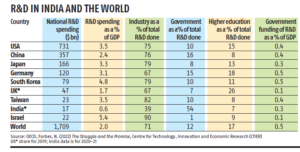ForumIAS announcing GS Foundation Program for UPSC CSE 2025-26 from 27th May. Click Here for more information.
Contents
Source: The post is based on the article “NRF: A landmark initiative” published in Business Standard on 20th July 2023.
Syllabus: GS 3 – Science & Technology
Relevance: About the National Research Foundation
News: The article discusses the National Research Foundation (NRF).
What is NRF?
The NRF funds scientific research rather than technological research. Academics from both public and private universities are eligible for NRF funding.
However, scientists working at autonomous national laboratories are only eligible for NRF funds if they collaborate with an academic researcher.
Read More: India’s National Research Foundation (NRF): Needs, significance and challenges
Why was NRF needed?
In comparison to other nations such as South Korea, Taiwan, Israel, Singapore, and China, India’s overall R&D investment is 0.6 percent of GDP.
Indian industry invests around 0.25 per cent of GDP in in-house R&D compared to a world average of 1.4 percent.
Further, unlike the rest of the world, India conducts its research in autonomous government institutions rather than universities. Due to which, India allocated only 0.04 percent of GDP for research done within the higher education system.
Hence, there was a need to scale the R&D investments both by the industry and by the government within the higher education system.
Read More: India’s National Research Foundation (NRF): Needs, significance and challenges
What are the challenges with NRF?
Dividing the Funding Amount: Initially, the 50,000-crore funding was supposed to be totally funded by the government. However, in the final proposal the amount is shared by the government and private entities.
This does not align with the global trend where the burden of funds is totally taken up by the government.
Amount below the Global Average: The funding amount of 10,000 crore per year would double research within the higher education system and raise its share from 0.04% to 0.1% of GDP. However, it still falls short of the global average of 0.35% of GDP.
Governance: The current governance structure of the NRF includes a high-level board chaired by the prime minister, with the ministers of education and science and technology as deputies. This makes it difficult to make them accountable.
However, instead of this, the board should consist of only professionals willing to dedicate the necessary time and energy and keep it free from any bureaucratic influence.
This board can then be accountable to the Cabinet, headed by the Prime Minister. This would be a more effective solution to the governance of NRF.
Read More: India’s National Research Foundation (NRF): Needs, significance and challenges
What can be the way ahead?
The NRF is indeed a landmark initiative. However, to achieve its potential, it is necessary that funds are properly utilized and those governing the NRF should be made accountable.
Source: Images from Business Standard






